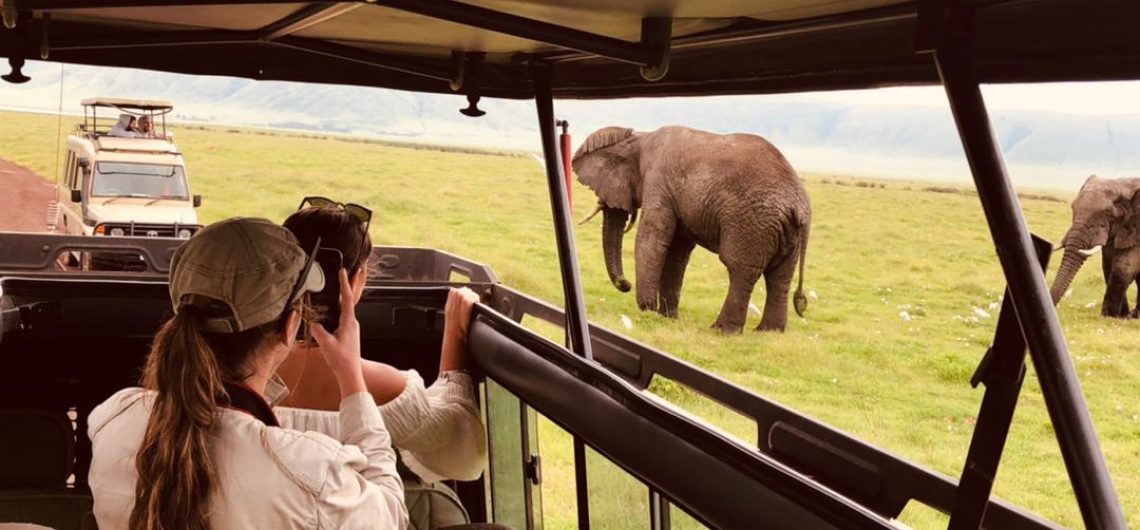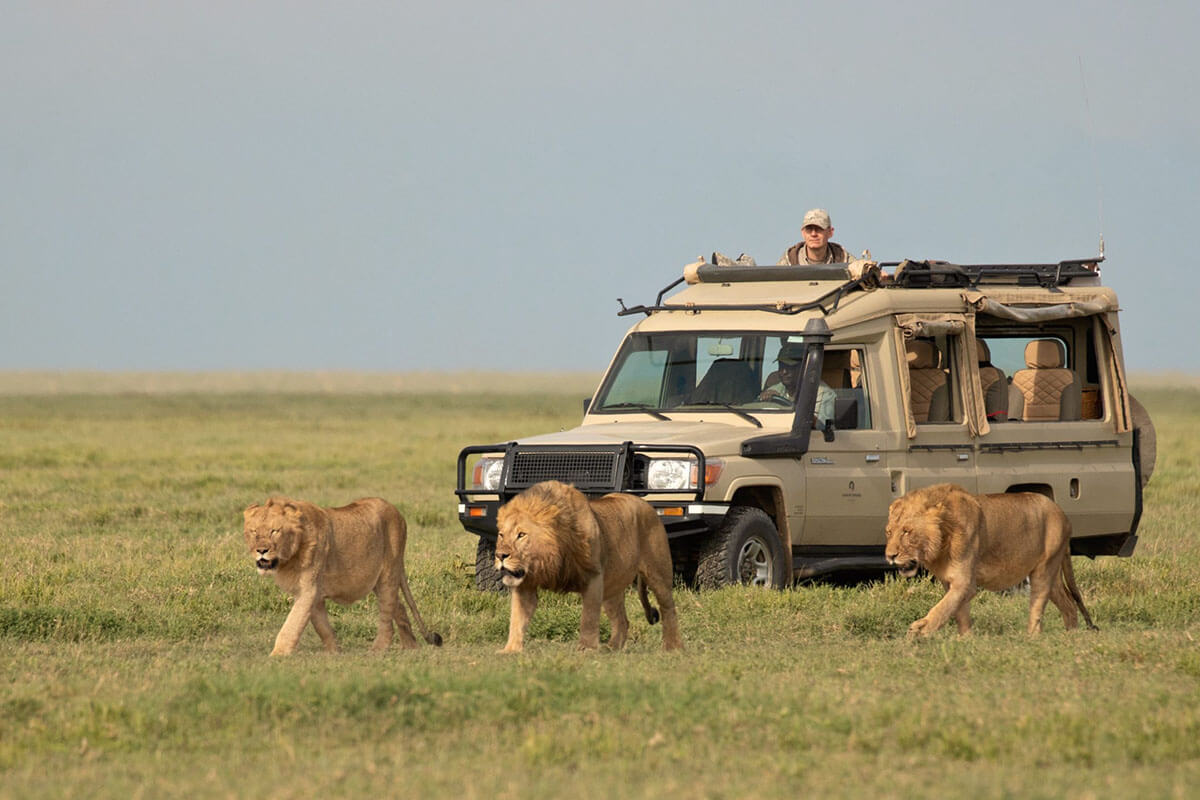Going on a safari after climbing Mount Kilimanjaro offers a perfect opportunity to complement your mountain adventure with an unforgettable wildlife experience.
You have made it at last! To the roof of Africa despite the test of endurance and stamina that has pushed you to your limits. But before you catch your flight back home, would you mind experiencing another side of the African Wilderness and exploring the best safari destinations in Tanzania?
Why you should do your trek before going on Safari
Doing the safari last allows you to rest more after the climb. You could be nervous about the hike, and you don’t want to be worried about it while on safari. After climbing for 6-9 days, it would be wonderful to go on safari and simply relax in the safari vehicle/jeep for a few days and take enjoy the lovely views that come with the breathtaking sceneries.
The safari might be your reward for your efforts in reaching the summit of Mt. Kilimanjaro!
Our fundamental logic is to do the most physically demanding aspects first.
Make the most of your time in Tanzania by taking a post-trek safari. Track lions across the Serengeti, count giraffes from a hot-air balloon, and sip drinks with new friends at the luxury camps and lodges dotted within the expansive Serengeti National Park and world-famous, Ngorongoro Crater.
Here are some reasons why you should consider going on a safari after climbing Kilimanjaro:
Rewarding Achievement:
Climbing Kilimanjaro is a challenging feat that tests your physical and mental limits. Going on safari afterward allows you to celebrate your accomplishment and indulge in a well-deserved treat.
Unforgettable Wildlife Encounters:
Tanzania’s national parks and reserves are teeming with diverse wildlife. Going on safari provides the opportunity to witness iconic animals like lions, elephants, giraffes, and more in their natural habitats.
The Great Wildebeest Migration:
Witnessing the Great Wildebeest Migration is a remarkable wildlife spectacle. After conquering Kilimanjaro, you can witness thousands of wildebeests and other animals crossing rivers and traversing the vast plains of the Serengeti.
Conservation Awareness:
Engaging in a safari experience allows you to learn about the importance of wildlife conservation. Seeing these majestic creatures up close instills a deeper appreciation for their conservation and the need to protect their habitats.
Cultural Immersion:
Tanzania is home to various indigenous tribes, such as the Maasai and Hadzabe. By going on safari, you can engage with local communities, learn about their traditional lifestyles, and gain insights into their rich cultural heritage.
Breathtaking Landscapes:
Tanzania boasts diverse and awe-inspiring landscapes, from the vast Serengeti plains to the stunning Ngorongoro Crater. After your Kilimanjaro climb, you can immerse yourself in the beauty of these landscapes during your safari adventures.
Photography Opportunities:
Both Kilimanjaro and safari offer incredible opportunities for photography. Capture the majestic beauty of Africa’s highest peak and then focus your lens on the stunning wildlife, landscapes, and sunsets during your safari adventure.
Relaxation and Renewal:
After the physical and mental exertion of climbing Kilimanjaro, a safari provides a chance to relax and rejuvenate. Unwind in comfortable lodges or tented camps, indulge in delicious cuisine, and enjoy the tranquility of the African wilderness.
Thrilling Game Drives:
Safari game drives offer a thrilling experience as you venture into the heart of wildlife-rich areas. Guided by experienced rangers, you’ll have the chance to spot animals up close, observe their behaviors, and create lasting memories.
Completing the Ultimate Tanzanian Adventure:
Combining a Kilimanjaro climb with a safari allows you to fully experience the wonders of Tanzania. From conquering Africa’s highest peak to witnessing the incredible wildlife, it’s a journey that offers a truly immersive and unforgettable adventure.
By going on safari after climbing Kilimanjaro, you can extend your Tanzanian adventure and create a well-rounded experience that encompasses both the exhilaration of summiting the mountain and the awe-inspiring beauty of Africa’s wildlife.
 Why choose Tranquil Kilimanjaro for your safari
Why choose Tranquil Kilimanjaro for your safari
Congratulations on successfully climbing Kilimanjaro! You’ve accomplished an incredible feat and now it’s time to make the most of your time in Tanzania with a post-trek safari. Here are seven reasons why you should consider letting Tranquil Kilimanjaro take the wheel:
- Expertise: Tranquil Kilimanjaro has been operating safaris in Tanzania since 1981, making them one of the most experienced and trusted safari operators. They have extensive knowledge of the country, its wildlife, and the best safari destinations.
- Tailored Itineraries: Tranquil Kilimanjaro offers a range of safari itineraries that can be customized to suit your preferences and interests. Whether you want to focus on specific wildlife, cultural experiences, or adventure activities, they can create a personalized itinerary just for you.
- Wildlife Encounters: Tanzania is renowned for its incredible wildlife, and a safari with Tranquil Kilimanjaro allows you to witness it firsthand. Track lions, elephants, cheetahs, and other iconic African animals across the vast plains of the Serengeti or explore the diverse ecosystems of Ngorongoro Crater.
- Unique Experiences: Tranquil Kilimanjaro goes beyond traditional game drives, offering unique experiences like hot-air balloon safaris over the Serengeti, guided walks with Maasai warriors, and visits to local communities to immerse yourself in the rich Tanzanian culture.
- Comfortable Accommodations: After the physical challenges of climbing Kilimanjaro, you deserve a comfortable and relaxing stay. Tranquil Kilimanjaro partners with high-quality lodges and camps that provide excellent amenities, delicious cuisine, and a comfortable environment to unwind after a day of safari adventures.
- Expert Guides: The safari guides from Tranquil Kilimanjaro are knowledgeable, experienced, and passionate about wildlife. They will share their expertise, point out wildlife sightings, and ensure you have a memorable and educational experience throughout your safari.
- Responsible Tourism: Tranquil Kilimanjaro is committed to responsible and sustainable tourism practices. They prioritize conservation, support local communities, and strive to minimize the environmental impact of their operations. By choosing Tranquil Kilimanjaro, you can feel good about your travel choices.
So, before you head home, consider extending your adventure with Tranquil Kilimanjaro and embark on a post-trek safari that will further immerse you in the natural beauty and wildlife of Tanzania. Let them handle the logistics and ensure you have a seamless and unforgettable safari experience.
Will I be too tired?
This is a common concern, but you’ll be surprised at how well-rested and energized you’ll feel after a day of relaxation following your Kilimanjaro trek. The safari experience doesn’t involve hiking, and you can simply enjoy the wildlife sightings from the comfort of a vehicle. You’ve already become accustomed to long days and early starts during your trek, so you’ll be well-prepared for the safari adventure.
What will I see on a post trek safari?
While there are no guarantees in wildlife sightings, that’s part of the excitement of a safari. The safari after Kilimanjaro takes you to Tarangire National Park, where you have a great chance of spotting the Big Five (African Elephant, Lion, Leopard, Cape Buffalo, and Rhinoceros). In addition to these iconic animals, you’ll also encounter other fascinating wildlife such as Giraffes, Baboons, Warthogs, and Waterbuck. Prepare to witness the diverse cast of characters from The Lion King.
How far away is it?
The best part is that Tarangire National Park is just an hour’s drive from your hotel (depending on traffic). You can relax and enjoy the journey, catching up on rest or spotting wildlife along the way. The proximity of the park makes it convenient to include a safari in your post-Kilimanjaro adventure.
Is it expensive?
Compared to longer bucket-list safaris that require flights, accommodation, and multiple days, the safari after Kilimanjaro is a budget-friendly option. The cost of the one-day safari is €250, which includes transfers, a safari guide, a packed lunch, bottled water, and entrance fees. It’s a unique opportunity to experience the Tanzanian wildlife without breaking the bank.
Is one day enough?
The duration of your safari depends on personal preference. If you’ve always dreamed of a multi-day safari experience with multiple game drives and stays in safari lodges, you have the option to extend your Kilimanjaro expedition with a three-day safari extension. This allows you to explore Tarangire National Park, Lake Manyara, and the Ngorongoro Crater while enjoying the comfort of incredible safari lodges. However, if you’re short on time or prefer a shorter safari experience, a one-day safari is still a fantastic opportunity to see wildlife and create lasting memories.
Kilimanjaro climb with a post-trek safari
Combining your Kilimanjaro climb with a post-trek safari, you can make the most of your time in Tanzania, immersing yourself in the country’s stunning wildlife and natural beauty. Whether you choose a one-day safari or opt for an extended adventure, it’s a perfect way to complement your Kilimanjaro achievement and create a well-rounded Tanzanian experience.
By going on a safari after climbing Kilimanjaro, you extend your journey, create lasting memories, and delve deeper into the remarkable natural and cultural heritage of Tanzania. It’s an opportunity to celebrate your achievement, connect with nature, and truly embrace the spirit of adventure.
![]()


 Why choose Tranquil Kilimanjaro for your safari
Why choose Tranquil Kilimanjaro for your safari
Comments